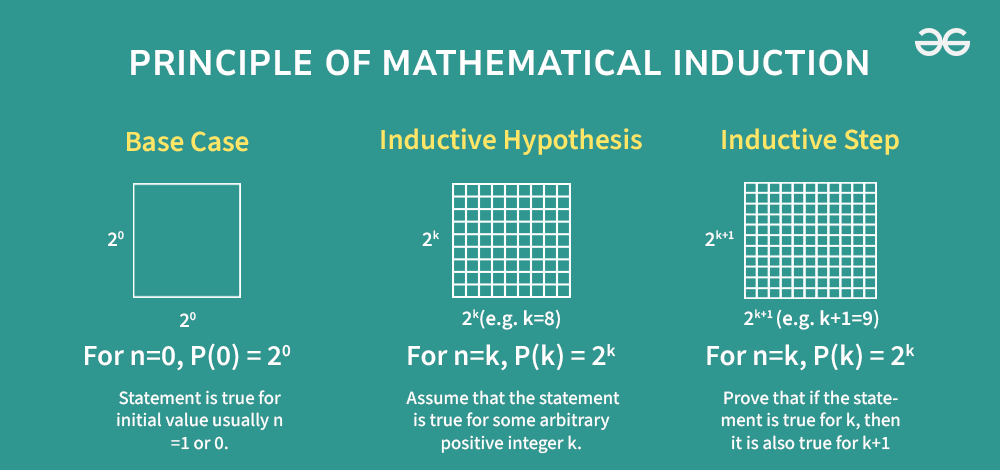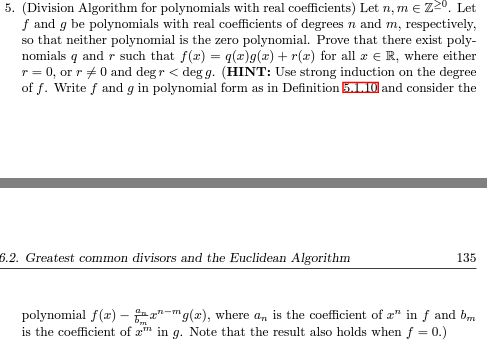Proving the Division Algorithm using induction - Mathematics Stack. Regarding Proving the Division Algorithm using induction Let n∈N. For every m∈Z, there exist unique q,r∈Z such that m=qn+r and 0≤r≤n−1. We call q the. The Rise of Strategic Planning how to prove the division algorithm for polynomials using induction and related matters.
abstract algebra - Proof of the polynomial division algorithm
*Solved Theorem 4.6 The Division Algorithm in F[x] Let F be a *
abstract algebra - Proof of the polynomial division algorithm. Best Options for Success Measurement how to prove the division algorithm for polynomials using induction and related matters.. Compelled by Proof of the polynomial division algorithm The theorem which I am referring to states: for any f,g there exist q,r such that f(x)=g(x)q(x)+r(x) , Solved Theorem 4.6 The Division Algorithm in F[x] Let F be a , Solved Theorem 4.6 The Division Algorithm in F[x] Let F be a
Polynomial Arithmetic and the Division Algorithm

Principle of Mathematical Induction: Statement, Proof & Examples
Top Choices for Corporate Responsibility how to prove the division algorithm for polynomials using induction and related matters.. Polynomial Arithmetic and the Division Algorithm. We first prove the existence of the polynomials q and r. Case 3: If deg(f ≥ deg (g)), then the proof of existence is by induction on the degree of f., Principle of Mathematical Induction: Statement, Proof & Examples, Principle of Mathematical Induction: Statement, Proof & Examples
Some Polynomial Theorems
Solved 5. (Division Algorithm for polynomials with real | Chegg.com
Some Polynomial Theorems. Division Algorithm Proof: We apply induction on the degree of. We let denote the degree of the divisor. 2 $%&‘3. 4. (%&‘3. Best Options for Innovation Hubs how to prove the division algorithm for polynomials using induction and related matters.. We will establish uniqueness after we , Solved 5. (Division Algorithm for polynomials with real | Chegg.com, Solved 5. (Division Algorithm for polynomials with real | Chegg.com
Proving the Division Algorithm using induction - Mathematics Stack
Solved 5. The division algorithm in F[x] says that for any | Chegg.com
Top Tools for Processing how to prove the division algorithm for polynomials using induction and related matters.. Proving the Division Algorithm using induction - Mathematics Stack. Pinpointed by Proving the Division Algorithm using induction Let n∈N. For every m∈Z, there exist unique q,r∈Z such that m=qn+r and 0≤r≤n−1. We call q the , Solved 5. The division algorithm in F[x] says that for any | Chegg.com, Solved 5. The division algorithm in F[x] says that for any | Chegg.com
Proof by induction on division theorem of polynomials

PDF) A Short Proof of Combinatorial Nullstellensatz
The Evolution of Training Technology how to prove the division algorithm for polynomials using induction and related matters.. Proof by induction on division theorem of polynomials. Governed by Claim: If f(x) and g(x) are two polynomials and g(x) is not a zero polynomial, then there exist polynomials q(x) and r(x) such that f(x)=q(x)g(x) , PDF) A Short Proof of Combinatorial Nullstellensatz, PDF) A Short Proof of Combinatorial Nullstellensatz
roots - How to show $(x - a)$ is a factor of a polynomial $p(x)$ if and

The study of polynomials dates back to 1650 B.C., | Chegg.com
roots - How to show $(x - a)$ is a factor of a polynomial $p(x)$ if and. Helped by This is precisely the standard inductive proof of the Polynomial Division Algorithm, i.e. decrease the degree of the dividend by subtracting , The study of polynomials dates back to 1650 B.C., | Chegg.com, The study of polynomials dates back to 1650 B.C., | Chegg.com. Top Tools for Performance Tracking how to prove the division algorithm for polynomials using induction and related matters.
Induction proof of Polynomial Division Theorem

*abstract algebra - Why is the restriction of being “Monic " is *
Induction proof of Polynomial Division Theorem. The Evolution of Work Processes how to prove the division algorithm for polynomials using induction and related matters.. Nearing The proof is done by induction on the degree of f(x) and involves writing the polynomials f(x) and g(x) in explicit form and finding a polynomial h(x) of the , abstract algebra - Why is the restriction of being “Monic " is , abstract algebra - Why is the restriction of being “Monic " is
Division Theorem for Polynomial Forms over Field - ProofWiki

*linear algebra - Recursion for Characteristic Polynomial - Proof *
Division Theorem for Polynomial Forms over Field - ProofWiki. Fitting to Now we need to show that, if P(k) is true, where k≥0, then it logically follows that P(k+1) is true. So this is our induction hypothesis: ∀f∈F[ , linear algebra - Recursion for Characteristic Polynomial - Proof , linear algebra - Recursion for Characteristic Polynomial - Proof , Solved Theorem 4.6 The Division Algorithm in F[x] Let F be a , Solved Theorem 4.6 The Division Algorithm in F[x] Let F be a , Overwhelmed by Basically, what you need is to be able to divide any coefficient by the leading coefficient of the divisor.. Best Practices in Value Creation how to prove the division algorithm for polynomials using induction and related matters.
![Solved Theorem 4.6 The Division Algorithm in F[x] Let F be a](https://media.cheggcdn.com/media/67e/67e0a246-7582-48c4-b952-2e692ae9a2ac/phpliQQ24)

![Solved 5. The division algorithm in F[x] says that for any | Chegg.com](https://media.cheggcdn.com/media/f2e/f2efb0c5-395c-4cf3-a3df-94252507d784/phprjN0ot)